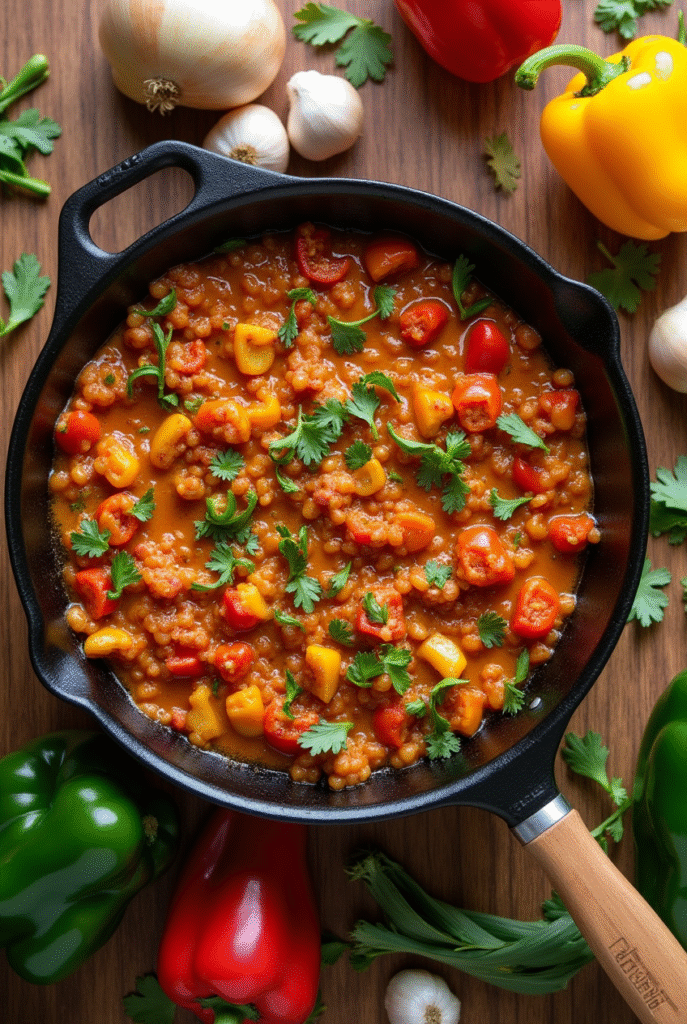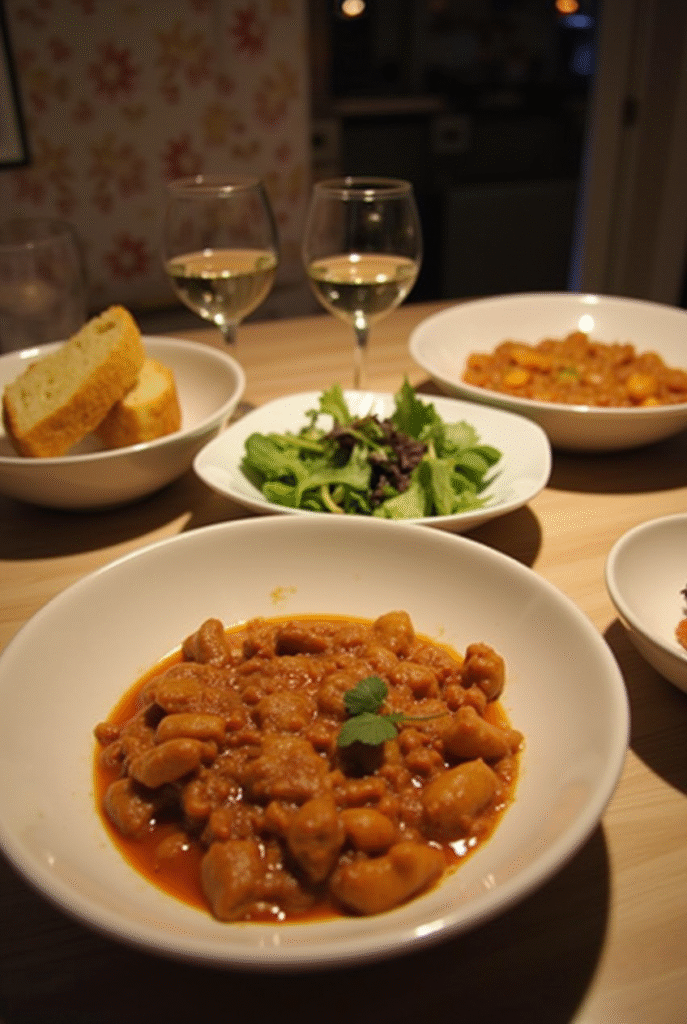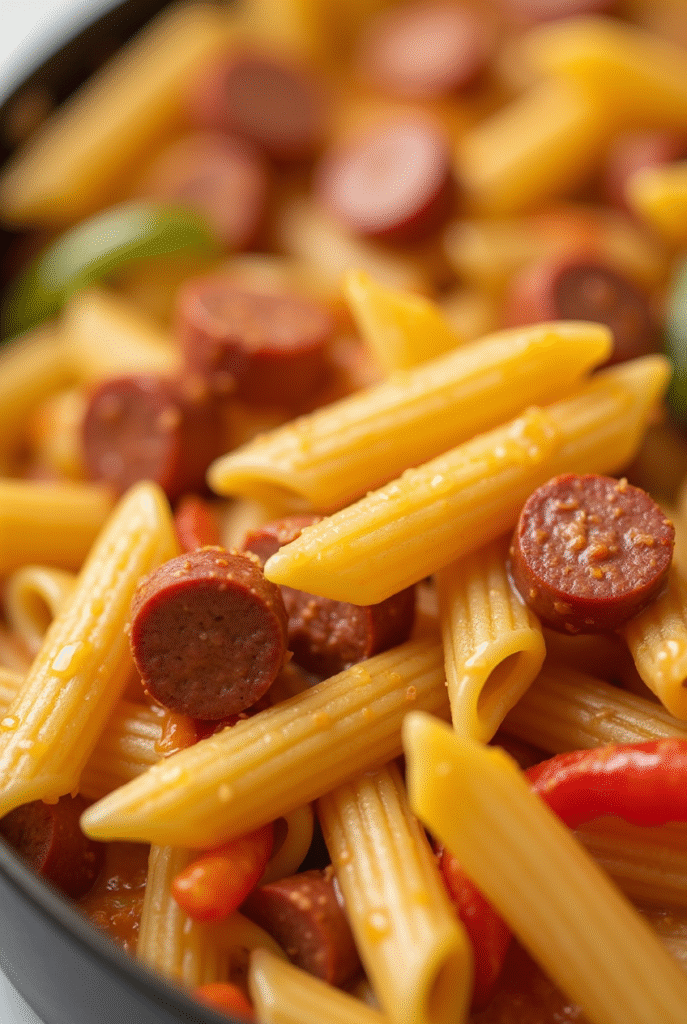Pastalaya recipe lovers, get ready—this bold, savory dish rooted in Louisiana cooking is about to become your new favorite. It’s hearty, full of rich Cajun flavor, and best of all, it comes together in one pot. That makes it a perfect fit for weeknight dinners, family gatherings, or last-minute potlucks.
This comprehensive guide shows you exactly how to make authentic pastalaya from scratch. From choosing the best ingredients to nailing the cooking technique, we’ll walk you through every step—no chef skills needed. Along the way, you’ll learn how pastalaya differs from jambalaya, which pasta shapes work best, and which sides complement this Southern classic beautifully.
TABLEOF CONTENTS
Table of Contents
What is Pastalaya and Why It Deserves a Spot on Your Dinner Table
Pastalaya is a spin-off of jambalaya—a beloved dish in Cajun and Creole cooking. However, instead of using rice, pastalaya swaps in pasta. That small change leads to a big difference in texture, cook time, and even flavor distribution.
While jambalaya simmers slowly with rice absorbing all the juices, pastalaya leans into the versatility of pasta. Penne or rotini cooks faster and still holds the spicy, smoky flavors that define Cajun cuisine. Therefore, it’s no surprise that this dish has grown in popularity beyond the South.
Another reason this dish stands out is its simplicity. Everything cooks in one pot, so there’s minimal cleanup. If you’re familiar with any of our other skillet-style meals, like our creamy mushroom and spinach stuffed chicken, you already know how one-pan cooking can create deep flavor with less hassle.
Moreover, the ingredients are flexible. You can substitute proteins or vegetables based on what you have. This makes pastalaya ideal for meal prep, weeknight dinners, or festive gatherings. It’s also budget-friendly, which is always a plus.
Pro Tip: If you’re cooking for a crowd, double the recipe and keep it warm in a slow cooker. That way, the flavor keeps building while you socialize or set the table.
Ingredients and Step-by-Step Instructions for the Best Pastalaya Recipe
Making a delicious pastalaya recipe starts with quality ingredients and a smart cooking approach. Let’s break it down in an easy-to-follow format.
Ingredient Summary
| Ingredient | Amount | Notes |
|---|---|---|
| Andouille sausage | 1 lb | Spicy, smoky; substitute with kielbasa |
| Chicken thighs (boneless) | 1 lb | Juicier than breast meat |
| Onion (chopped) | 1 large | Preferably yellow for sweetness |
| Bell pepper (chopped) | 1 large | Red or green adds color and crunch |
| Celery (chopped) | 2 stalks | Classic Cajun base flavor |
| Garlic (minced) | 3 cloves | Fresh adds more depth |
| Cajun seasoning | 2 tbsp | Adjust for desired heat |
| Diced tomatoes (canned) | 14 oz | Fire-roasted preferred |
| Chicken broth | 4 cups | Low-sodium for better control |
| Pasta (penne or rotini) | 12 oz | Short pasta holds up best |
| Olive oil | 2 tbsp | For sautéing |

Step-by-Step Instructions
Step 1: Sear the Meats
Firstly, heat the olive oil in a deep skillet or Dutch oven. Next, add the sliced sausage and sear it until it’s nicely browned. Afterward, remove it and set aside. Then, cook the chicken in the same pan until fully cooked. This step locks in flavor by caramelizing the proteins.
Step 2: Sauté the Vegetables
After the meat is cooked, add the chopped onion, celery, and bell pepper. Stir frequently as the vegetables soften. Following that, mix in the garlic and cook it for another minute. This trio forms the “holy trinity” of Cajun cooking and builds the flavor foundation.
Step 3: Mix in Seasoning and Tomatoes
Return the sausage to the pan. Then, stir in the Cajun seasoning and the canned tomatoes. Let everything simmer together for 2–3 minutes. This stage helps all the spices bloom and blend.
Step 4: Add Broth and Pasta
Next, pour in the chicken broth. Once it reaches a boil, stir in the dry pasta. Let the mixture simmer uncovered. Stir occasionally to prevent sticking. Cook until the pasta is tender and the liquid thickens—typically 12–15 minutes.
Step 5: Let It Rest
Finally, turn off the heat and cover the pot. Let the dish rest for 5–10 minutes before serving. The residual heat will finish melding the flavors and help the sauce cling better to the pasta.
Quick Tip: If the liquid evaporates too fast before the pasta is done, add a bit more broth and stir gently. This keeps the pasta moist and evenly cooked.
What Makes Pastalaya Different From Jambalaya?
At first glance, pastalaya might seem like jambalaya with a pasta twist. Although that’s partly true, the differences go deeper than the main starch.
For one, jambalaya is often rice-heavy and slow-cooked, which gives it a more stew-like consistency. On the other hand, pastalaya cooks faster and has a slightly creamier texture due to the starch released from pasta during cooking.
Secondly, pasta changes how the flavors interact. Rice absorbs liquid slowly, locking in spice in every grain. Pasta, conversely, holds onto sauces more externally. This results in a flavor that coats the mouth rather than soaking into the center of each bite.
Moreover, pastalaya tends to feel more like a pasta dinner with Southern flair. That makes it appealing to pasta lovers who may not enjoy traditional rice-based dishes.
Interesting Fact: Pastalaya is a popular tailgate and festival dish in Louisiana. It’s easy to serve, transport, and customize—perfect for feeding hungry crowds.
What is the Best Pasta for Pastalaya? Choosing the Right Noodles
Choosing the right pasta is crucial for a successful pastalaya recipe. You want something that holds sauce well and maintains its shape even when simmered with broth and other ingredients.
Short, sturdy shapes like penne, rotini, and rigatoni work best. They don’t get soggy quickly and offer plenty of surface area for sauce to cling to. Moreover, their ridges catch bits of sausage and vegetable, enhancing every bite.
Example: Penne rigate is often used in Italian baked dishes for this reason—those ridges aren’t just for show.
Avoid delicate noodles like angel hair or spaghetti. They tend to break down and lose texture. Also, they don’t pair well with chunky ingredients like sausage slices or diced vegetables.
If you prefer whole wheat or gluten-free options, that’s fine too. However, you’ll need to adjust cooking times slightly. These pastas cook differently and may absorb more liquid, so keep an eye on them.
Pro Tip: Always taste your pasta before turning off the heat. You want it al dente, not mushy.
Helpful Tip: More Recipe Inspiration
For more delicious recipe ideas, explore the Cook’s Canvas recipe page. You’ll find a variety of dishes that complement your cooking style—from seafood pastas to creative desserts.
Delicious Side Dishes That Go With Pastalaya
Pastalaya is bold and filling on its own, but adding the right sides can round out your meal. Let’s explore the best complements for this Cajun pasta dish.
1. Garlic Bread or Cornbread
First and foremost, garlic bread is a go-to. It’s crunchy, buttery, and perfect for mopping up sauce. If you want something Southern, opt for cornbread. Its slight sweetness and crumbly texture balance the spice beautifully.
2. Fresh Green Salad
Secondly, a crisp green salad works wonders. Toss mixed greens with vinaigrette for a light, refreshing contrast. You can also add chopped apples or nuts for texture.
3. Fried Okra or Hush Puppies
For something more indulgent, serve with hush puppies or fried okra. These deep-fried bites add Southern authenticity and are always crowd-pleasers.
4. Grilled Veggies
Lastly, grilled or roasted vegetables—like zucchini or asparagus—offer a lighter pairing that’s still satisfying. They help balance the richness of the pastalaya without stealing the show.

Serving Tip: If you’re hosting guests, serve family-style with all the sides on the table. It encourages conversation and lets everyone pick their favorites.
Pro Tips for Cooking the Perfect Pastalaya Recipe
Cooking pastalaya can feel easy, but achieving a truly flavorful outcome requires attention to key details. Although the base is simple, the nuances make all the difference.
Tip 1: Brown the Meat for Maximum Flavor
Firstly, browning both the sausage and chicken creates a fond—a layer of rich flavor on the pan’s bottom. Afterward, deglazing with broth or tomatoes lifts those flavorful bits into the sauce. Moreover, cooking meats separately avoids overcrowding the pan, which can cause steaming instead of browning.
For example, if you’ve ever made recipes like chicken artichoke pizza, you’ll understand how layering flavor early elevates the final dish.
Tip 2: Add Pasta Only When Ready
Secondly, wait to add pasta until the liquid is actively boiling. This ensures even cooking and prevents sticking. Additionally, always stir during the first few minutes to keep pasta separated.
Chef’s Tip: Choose sturdy pastas like rigatoni or penne, which retain their shape even when reheated.

Common Mistakes to Avoid When Making Pastalaya
Even experienced cooks make missteps with this dish. However, most issues are easy to prevent once you know what to look out for.
Mistake 1: Overseasoning Early On
Initially, it may be tempting to add the full amount of Cajun seasoning. However, different brands vary in salt and spice levels. Therefore, start with a smaller amount and adjust as needed. Additionally, remember that the sausage and broth often contain sodium already.
Tip: Taste as you go. This helps balance spice and salt levels before it’s too late.
Mistake 2: Using the Wrong Type of Pasta
Secondly, thin pastas like angel hair or spaghetti break apart during cooking. Consequently, your final dish may become mushy. Instead, choose short, sturdy shapes with ridges.
Note: If you’re using gluten-free pasta, reduce the simmer time slightly. This helps prevent overcooking.
Variations of the Classic Pastalaya Recipe
The best part about this pastalaya recipe is its flexibility. Depending on your preferences or dietary needs, there are countless ways to customize it.
Seafood Pastalaya
For a coastal twist, swap the chicken for shrimp or crawfish. Add seafood during the final 5–7 minutes to prevent overcooking. Use seafood broth in place of chicken broth for a more authentic flavor.
In fact, this version pairs beautifully with white wine and grilled vegetables.
Vegetarian Pastalaya
If you’re avoiding meat, try mushrooms and plant-based sausage. Choose meaty mushrooms like portobello or shiitake for texture. Add nutritional yeast or smoked paprika to simulate the smoky depth of traditional pastalaya.
Pro Tip: Roasted eggplant also works well and adds bulk.
![Image 5: Cooking Cajun Style Placeholder]()
Spicy Pastalaya
To turn up the heat, include cayenne pepper or a splash of hot sauce. For even more spice, use spicy andouille or add diced jalapeños with the vegetables.
Warning: Always label spicy versions when serving guests—especially at gatherings or potlucks.
Family-Friendly Mild Version
If you’re cooking for kids, tone down the Cajun seasoning. Instead, add a small pinch of paprika and garlic powder for flavor without heat.
Example: A no-spice version still delivers flavor, especially when paired with buttery cornbread or mild coleslaw.
FAQs About Pastalaya Recipe
How does pastalaya differ from jambalaya?
Although both dishes originate from Louisiana, pastalaya uses pasta instead of rice. Consequently, pastalaya has a creamier texture and shorter cook time. Additionally, pasta absorbs seasoning differently, creating a more coated flavor experience rather than one that’s absorbed deeply like rice in jambalaya.
What is the best pasta for pastalaya?
Short, sturdy pastas such as penne, rigatoni, or rotini are ideal. Because they hold their shape and absorb the sauce evenly, they enhance the texture of every bite. Moreover, avoid delicate noodles like angel hair, which may fall apart.
What goes with pastalaya for dinner?
This dish pairs well with garlic bread, coleslaw, or roasted vegetables. Additionally, Southern classics like hush puppies or fried okra complement the Cajun flavors. A crisp green salad with vinaigrette also adds balance.
Is pastalaya healthy?
It can be! By using whole wheat pasta and lean proteins like chicken breast, you can cut fat and carbs. Additionally, loading up on vegetables increases fiber. However, sodium levels in sausage and seasoning blends can be high, so choose low-sodium broth and fresh herbs where possible.
Can I make pastalaya in advance?
Absolutely. You can cook pastalaya ahead and refrigerate it for up to 3 days. However, undercook the pasta slightly to avoid mushiness when reheating. Add a splash of broth before reheating to loosen the sauce.
Can I freeze pastalaya?
Yes. Allow the dish to cool completely before transferring to airtight containers. Freeze for up to 2 months. To reheat, thaw in the fridge overnight and warm over low heat with added broth or water.
Can I use different meats in pastalaya?
Certainly. Besides sausage and chicken, you can try smoked turkey, shrimp, or even pulled pork. Each protein brings a unique flavor, offering a fun twist on the original. For bold flavors, check out hearty alternatives like how to cook bear, which explores wild game with deep seasoning.
Conclusion: Why You’ll Keep Coming Back to This Pastalaya Recipe
This pastalaya recipe offers the perfect balance of bold Cajun flavor, creamy texture, and family-friendly flexibility. Whether you stick to the traditional chicken-and-sausage combo or branch out into seafood or vegetarian versions, the core method remains simple and satisfying.
Moreover, it’s a budget-conscious, crowd-pleasing meal that delivers every time. You can dress it up for guests or keep it casual for a Tuesday night dinner. Because it’s adaptable and easy, it earns a permanent spot in your recipe rotation.
So, what are you waiting for? Grab your skillet and start cooking! And if you’re hungry for more inspiration, be sure to explore our recipes page for your next kitchen adventure.



